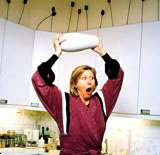Do it yourself
During her recent visit to the Milan Furniture Fair, Lynda Relph-Knight sampled a Dutch exhibit with a distinct difference

Visitors to shows such as the Milan Furniture Fair might think that 3D design is just about the creation of objects. Milan represents the obsession most manufacturers and designers have with style as they strive to reinvent everyday items such as the chair in line with fashion.
There are designers like Ron Arad or Philippe Starck, who push ideas and technology in a delightful way. But apart from the invitation to sit on, crawl under or touch some of the exhibits, there’s little scope for public interaction at the fair. It’s more about selling products that dictate use and lifestyle.
How refreshing, therefore, to find in Milan a collaboration that takes the opposite view. Dutch innovator Droog Design has joined with Do, an umbrella “brand”, also based in Amsterdam, that encompasses the work of several international designers, to create a show that encourages punters to create their own “designs” or change what exists. It also encourages people to express emotions such as anger and joy through the way they react with the “products”.
The show, Do + Droog Design = Do Create, involves six individual designers РThomas Bernstrand, Jurgen Bey, Dawn Finley, Dick van Hoff, Marijn van der Poll and Marti Guix̩. There are three groups РFrank Tjepkema & Peter van der Jagt and Thomas Widdershoven & Dinie Besems and Radi Designers.
Bold graphics invite people to Do… whatever, while Bianca Pilet’s huge colour photographs of people “doing” provide an entertaining backdrop.
The breadth of interpretation of the theme, Do Create, ranges from Van Hoff’s practical Do Design, urging visitors to make a plastic lampshade from a kit or a chair from a wooden plank and saw, to Finley’s simple Do Post exhibit, which invites them to write on chocolate box-style postcards and “post” them in a metal box.
Guixé contributed four of the 12 exhibits. Do Eat has plastic plates formed and cut from a single sheet around the dining table; Do Link provides a lampshade and base that only needs a drainpipe, tree trunk or similar to make a lamp; while Do Reincarnate comprises a connector to link, say, a table lamp to a ceiling lightfitting to create a chandelier. But her wittiest offering is Do Frame, masking tape printed with the decoration of an ornate picture frame.
Among the best, though, are those exhibits that directly address human emotion. Tjepkema and Jagt’s Do Break centres on a simple vase broken in an argument and glued back together as the couple makes up. The cracked version has the tactile qualities of eggshell, while the fixed model takes on a rubbery feel with all the silicone glue inside it.
Van der Poll’s Do Hit involves wielding a mallet to attack a metal cube to create a crude chair. But the most exuberant is Bernstrand’s Do Swing, a simple “chandelier” on which to swing with rage or joy across your living room.
Is this “art” or will such interaction catch on? Probably, given the effect Droog’s experimentation with materials is already having on mainstream manufacture. The impression, if not the feel, of Robin Levien’s latest loo for Ideal Standard, for example, isn’t far removed from the Rapsel-sponsored Soft Toilet prototype by Droog’s Arnout Visserand and Erik Jan Kwakkel – a ceramic bowl encased in a pale blue silicone rubber sleeve.
Tactility is a great way to make design more accessible, and as it becomes more accessible people will feel more relaxed about enjoying it.
-
Post a comment




